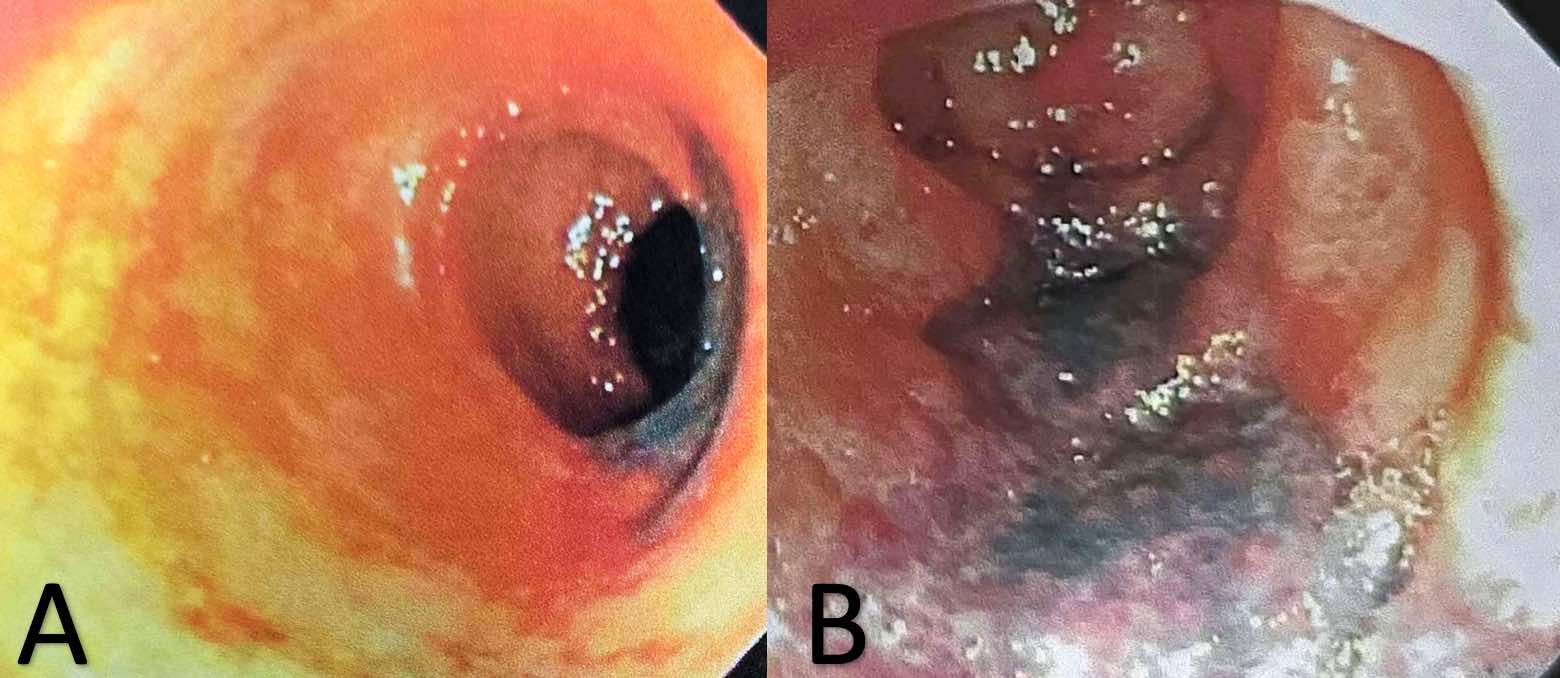Sunday Poster Session
Category: General Endoscopy
P0894 - Colonoscopy Preparation-Induced Ischemic Colitis: Risk Factors, Mechanisms, and Clinical Management
Sunday, October 26, 2025
3:30 PM - 7:00 PM PDT
Location: Exhibit Hall

Kelsey Lamb, DO
HCA Florida Largo Hospital
Largo, FL
Presenting Author(s)
Kelsey Lamb, DO, Kelly Volland, DO, Lisa Luckey, DO, Patricia Chun, DO, Christopher Halleman, DO
HCA Florida Largo Hospital, Largo, FL
Introduction: Colonoscopy is the cornerstone in the diagnosis, screening, and management of colorectal diseases. A critical component of this procedure is bowel preparation. Bowel ischemia induced by colonoscopy preparation poses unique challenges for clinicians due to its nonspecific presentation, often mimicking other gastrointestinal conditions. This report aims to explore the incidence, risk factors, clinical manifestations, and management of colonoscopy pre-induced bowel ischemia.
Case Description/
Methods: A 43-year-old female presented with complaints of abdominal cramping and hematochezia the morning of a routine screening colonoscopy. That evening after taking her bowel preparation, the abdominal cramping again returned; however, it was now accompanied by hematochezia. She underwent screening colonoscopy that showed grade I internal hemorrhoids, 1 mm rectal polyp, and patchy colitis from 23 to 60 cm that was biopsied and tattooed proximally and distally. Pathology revealed acute colitis with no granulomas consistent with acute self-limited colitis.
Discussion: The mechanism behind colonoscopy preparation-induced ischemia appears to be multifactorial, involving hypovolemia, electrolyte disturbances, and pre-existing vascular insufficiency. Osmotic and stimulant laxatives used in bowel preparation can exacerbate these factors, particularly in vulnerable populations such as elderly individuals, those with cardiovascular disease, and patients with chronic renal insufficiency. The incidence of this rare complication is approximately 0.02% in the United States
Management depends on the severity of the presentation. Mild cases may resolve with conservative measures such as bowel rest, intravenous hydration, and symptom management. However, severe cases with extensive ischemia, necrosis, or perforation may require surgical intervention.
Moving forward, a balanced approach to bowel preparation is essential. Strategies such as individualized prep protocols, adequate hydration, and close monitoring of high-risk individuals may mitigate the risk of ischemic complications. Further research is needed to better understand the mechanisms of prep-induced bowel ischemia, refine screening protocols, and develop safer preparation methods. By prioritizing patient safety, healthcare providers can continue to maximize the benefits of colonoscopies while minimizing its risks.

Figure: A: Patchy colitis noted from 23 to 60 cm on colonoscopy with status post tattooing at the proximal end. B: Patchy colitis noted from 23 to 60 cm on colonoscopy.
Disclosures:
Kelsey Lamb indicated no relevant financial relationships.
Kelly Volland indicated no relevant financial relationships.
Lisa Luckey indicated no relevant financial relationships.
Patricia Chun indicated no relevant financial relationships.
Christopher Halleman indicated no relevant financial relationships.
Kelsey Lamb, DO, Kelly Volland, DO, Lisa Luckey, DO, Patricia Chun, DO, Christopher Halleman, DO. P0894 - Colonoscopy Preparation-Induced Ischemic Colitis: Risk Factors, Mechanisms, and Clinical Management, ACG 2025 Annual Scientific Meeting Abstracts. Phoenix, AZ: American College of Gastroenterology.
HCA Florida Largo Hospital, Largo, FL
Introduction: Colonoscopy is the cornerstone in the diagnosis, screening, and management of colorectal diseases. A critical component of this procedure is bowel preparation. Bowel ischemia induced by colonoscopy preparation poses unique challenges for clinicians due to its nonspecific presentation, often mimicking other gastrointestinal conditions. This report aims to explore the incidence, risk factors, clinical manifestations, and management of colonoscopy pre-induced bowel ischemia.
Case Description/
Methods: A 43-year-old female presented with complaints of abdominal cramping and hematochezia the morning of a routine screening colonoscopy. That evening after taking her bowel preparation, the abdominal cramping again returned; however, it was now accompanied by hematochezia. She underwent screening colonoscopy that showed grade I internal hemorrhoids, 1 mm rectal polyp, and patchy colitis from 23 to 60 cm that was biopsied and tattooed proximally and distally. Pathology revealed acute colitis with no granulomas consistent with acute self-limited colitis.
Discussion: The mechanism behind colonoscopy preparation-induced ischemia appears to be multifactorial, involving hypovolemia, electrolyte disturbances, and pre-existing vascular insufficiency. Osmotic and stimulant laxatives used in bowel preparation can exacerbate these factors, particularly in vulnerable populations such as elderly individuals, those with cardiovascular disease, and patients with chronic renal insufficiency. The incidence of this rare complication is approximately 0.02% in the United States
Management depends on the severity of the presentation. Mild cases may resolve with conservative measures such as bowel rest, intravenous hydration, and symptom management. However, severe cases with extensive ischemia, necrosis, or perforation may require surgical intervention.
Moving forward, a balanced approach to bowel preparation is essential. Strategies such as individualized prep protocols, adequate hydration, and close monitoring of high-risk individuals may mitigate the risk of ischemic complications. Further research is needed to better understand the mechanisms of prep-induced bowel ischemia, refine screening protocols, and develop safer preparation methods. By prioritizing patient safety, healthcare providers can continue to maximize the benefits of colonoscopies while minimizing its risks.

Figure: A: Patchy colitis noted from 23 to 60 cm on colonoscopy with status post tattooing at the proximal end. B: Patchy colitis noted from 23 to 60 cm on colonoscopy.
Disclosures:
Kelsey Lamb indicated no relevant financial relationships.
Kelly Volland indicated no relevant financial relationships.
Lisa Luckey indicated no relevant financial relationships.
Patricia Chun indicated no relevant financial relationships.
Christopher Halleman indicated no relevant financial relationships.
Kelsey Lamb, DO, Kelly Volland, DO, Lisa Luckey, DO, Patricia Chun, DO, Christopher Halleman, DO. P0894 - Colonoscopy Preparation-Induced Ischemic Colitis: Risk Factors, Mechanisms, and Clinical Management, ACG 2025 Annual Scientific Meeting Abstracts. Phoenix, AZ: American College of Gastroenterology.
